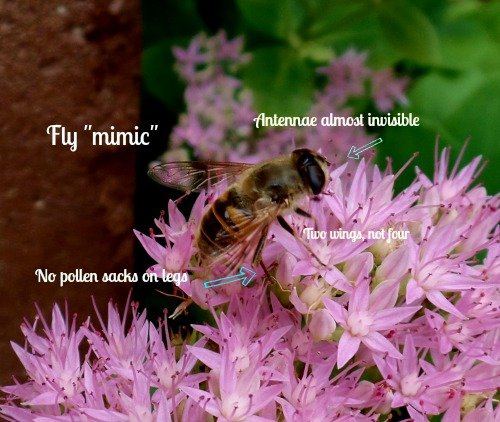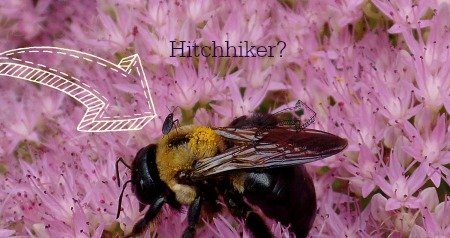Thankful For Our Joyful Pollinators!
Lots of Joyful Pollinators !
Up Close and Personal!
My Autumn Joy is budding and will soon be blooming profusely , along with the Vera Jamison, and it will be just full of bees! Or I guess I should say pollinators because some of them are the not bees but are bee mimics. Maybe some type of fly or wasp or whatever. The butterflies are fluttering around the flowers also.
These pollinators seemed “drunk” on the pollen or nectar because I can get so close to photograph them. It was really nice to see a close up photo of these. And I am not sure that I am identifying them correctly. It seems so difficult, when I read about all the similarities, and then a list of all the differences. By all means, if I am not identifying something correctly, please let me know so that I can correct it.
I think this is an Eastern carpenter bee (Xylocopa virginica) because of the shiny abdomen. It has the “elbowed” antennae of the bees. Some western and southwestern carpenter bees have a different appearance, some being blonde or orange on their bodies. But this is the one I am familiar with in my garden here in Ohio.
These carpenter bees burrow into wood (usually unpainted) making a hole to lay their eggs. They will even burrow into treated wood, though it might be the last type of wood they would settle for. Smaller carpenter bees nest in the pithy stems of woody plants. I see sawdust sometimes around my hydrangea bush.

My Sedum “Autumn Joy” is planted in the side garden nearest a wooden fence, so I suppose I am serving the nectar they want just near their homes in the fence. I do see some holes in the fence each year, but since we need the pollinators, we will live with it.
These carpenter bees are very non-aggressive and just make loud buzzing noises, but don’t sting. The male will buzz around you “checking you out” but they are not stinger-type bees. So they do no harm, even though you may not like the holes in the wood. But try not to mind so much since these bees do a lot of good in our environment.

The drone carpenter bee is said to have a white spot on its head. They can’t sting, so they are just loud buzzers in the garden.
Even the hole in your wood is probably only cosmetic, so leave these bees to do what they are meant to do….pollinate!
Fly Mimics Are Pollinators
Some insects take on the “look” of a bee to protect themselves. They know predators don’t bother those that sting. So they adapt to look like the bee. These flies look like bees, right?
I noted the picture with the reasons why I thought this one is a fly instead of a bee. So let me know if you think differently.
Bats and Lizards and Moths – The Night Pollinators

There are other pollinators which seem, at first glance, not to be pollinators, but they are! Bats and lizards pollinate by brushing their long tongues inside flowers to get the nectar and carry some pollen on to the next flower they visit. Check out this slideshow for reference.
Think of it as the night shift which takes over the pollination duties. Don’t forget these bats and moths fly through the night and are attracted to night-blooming flowers and those with a scent. Often deeply scented, flowers that are white or pale stand out in the evening and night air and hold their pollen in wait. So look again at that bat. Don’t forget him or her in favor of the bees!
But it’s the insects that have always fascinated me. I can’t help but put in a few here and there on the blog when I see the need as I discuss the garden. Let me know how you feel about the insects in your garden!
And the bats and lizards and moths! They are all our Joyful Pollinators.




Thank you Kim for this wonderful article! The pictures were spot on and very helpful in their detail. I love reading your articles!
Oh, thank you so much. How wonderful you are for commenting and letting me know.